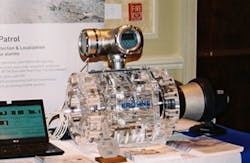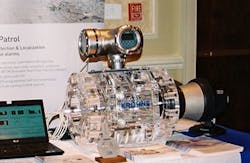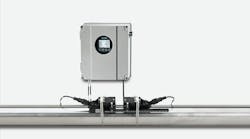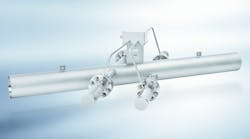When most people talk about ultrasonic flowmeters, they are thinking of transit-time meters. Transit-time ultrasonic flowmeters work best with clean fluids, but suppliers have evolved the technology so it can also accurately measure the flow of fluids with some impurities.
Doppler flowmeters are the other main type of ultrasonic technology. Doppler meters rely on the presence of particles in the flowstream, since their principle of operation requires that they bounce an ultrasonic signal off particles or impurities in the flowstream in order to measure flowrate. Doppler ultrasonic flowmeters have been diminishing in popularity as transit-time technology has improved. However, Doppler meters remain important because measuring the flow of dirty fluids is a difficult measurement for most other flowmeters. Magnetic flowmeters are one of the few other types of flowmeters that can measure the flow of dirty liquids.
Ultrasonic meters can also be differentiated by mounting type, of which there are three commonly applied to ultrasonic meters:
- Insertion
- Clamp-on
- Inline (spool piece)
Insertion flowmeters are widely used for flare and stack gas monitoring, as well as for measuring exhaust emissions. Insertion meters are a good choice in these applications because the stacks and chimneys are often too large in diameter to make an inline meter practical. Insertion ultrasonic flowmeters compete with averaging Pitot tubes and thermal meters in these applications. They can also be hot-tapped or cold-tapped into a pipe to make a measurement when meter cost is a consideration and high accuracy is not required.
Clamp-on flowmeters attach to the outside of a pipe—typically there is both a sending and a receiving transducer. They benefit from the advantage that they do not interfere with the flow of the process fluid, and hence cause no pressure drop. Many also have the advantage of portability; although clamp-on meters come in both portable and fixed types. Clamp-on meters are not as accurate as inline meters because there are several variables that can impact their accuracy. One is the thickness and material of the pipe wall, which can attenuate the signal. Another is buildup in the pipe, which can affect the pipe diameter and, thus, the accuracy of the clamp-on meter.
Inline transit-time flowmeters are the most accurate type of ultrasonic meter. They come in single, dual, and multipath designs. Multipath designs measure flow at multiple locations, thereby enhancing measurement accuracy. Suppliers have made many types of multipath meters, including 3-path, 4-path, 5-path, 6-path, 8-path, and 18-path designs, among others. Flowmeters for custody transfer of natural gas are required to be multipath in design. The requirements are laid out in AGA-9, a report by the American Gas Association (AGA) on the use of ultrasonic flowmeters for custody transfer applications. Ultrasonic flowmeters for custody transfer of natural gas compete with differential pressure (DP) and turbine flowmeters, both of which also have AGA approval.
Inline ultrasonic flowmeters are also used for measurement of crude oil and petroleum liquids. Consistently high crude oil prices have made measurement of the flow of petroleum liquids increasingly important.
Jesse Yoder, Ph.D., is president of Flow Research Inc. in Wakefield, Mass., a company he founded in 1998. He has 25 years of experience as an analyst and writer in process control. Dr. Yoder specializes in flowmeters and other field devices, including pressure and temperature products. Dr. Yoder can be reached at [email protected].



